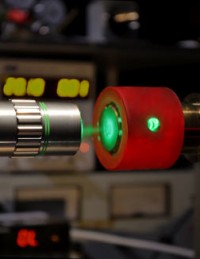Elusive hot hydrogen leads to more questions

Experiments by researchers in the School's Centre for Science at Extreme Conditions (CSEC) have revealed anomalous behaviour in the melting temperatures of high-pressure dense hydrogen.
As reported in the prestigious "Nature Materials”, the study provides evidence that at above 200 GPa (2,000,000 atm) surprisingly low temperatures (480 K) are required to reach a liquid phase.
As the simplest, lightest and most abundant element of the Universe, hydrogen is of fundamental interest in many fields of physics. At high pressure and low temperatures, hydrogen is predicted to transform to a new type of ordered quantum fluid possessing both superconducting and superfluid properties. The high temperature behaviour is crucial to planetary science as hydrogen is believed to be found in the centre of Jovian planets and to be the source of their exceptionally high magnetic fields. Reaching such conditions in the experimental laboratory, long enough to comprehensively study the material, has been a great challenge in the field of high pressure research. Even high compression at room temperature was thought to be beyond experimental capabilities until recently.
Through new technological breakthroughs in the containment of hot hydrogen in diamond anvil cell experiments, Ross Howie, Philip Dalladay-Simpson and Eugene Gregoryanz at the Centre for Science at Extreme Conditions, provide evidence that after a maximum in the melting curve, the melting temperatures of hydrogen rapidly decrease with pressure, dropping to 480 K at 255 GPa. This consequently results in the lowest melting temperature for any material at such pressures.
Tracking this transformation over a large pressure regime through Raman spectroscopy, the team also discovered a triple point between hydrogen’s solid molecular Phase I, the recently discovered solid mixed molecular-atomic phase IV and the liquid phase.
Remarkably, at pressures above 260 GPa the melting line flattens out, raising many questions about the high pressure, high temperature behaviour of hydrogen at even higher densities. If the melting curve were to increase at higher densities then the phase diagram would markedly resemble what is observed in the rest of the group I elements in the periodic table. Such behaviour questions the existence of the exotic states that hydrogen has been theoretically predicted to possess and at the very least pushes the transition pressures much higher than previously thought.
“It is remarkable to think that 4 years ago, researchers were unable to compress hydrogen above 180 GPa and 200 K, and now we are probing the melt line, far surpassing these conditions. Although this study is a major breakthrough in hydrogen research, it poses more questions about its high pressure behaviour and may even cast doubt on the existence of predicted exotic phases. Nevertheless it is very exciting to think what may occur at higher densities and will no doubt stimulate further research.” Ross Howie, Centre for Science at Extreme Conditions

